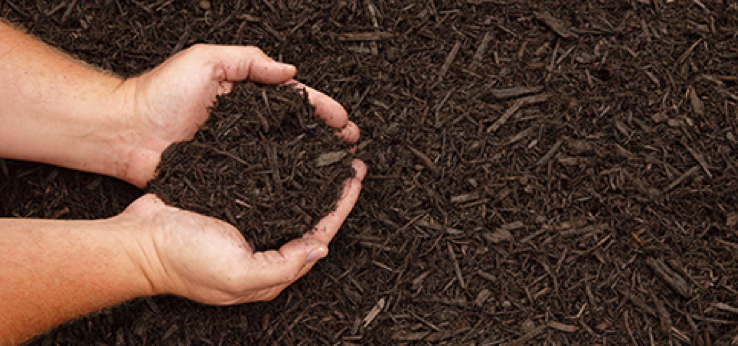Mulches are the Swiss Army Knife of landscape applications. They come in many forms and serve many functions: covering bare ground in shrub beds, around annuals, and in tree wells, and working behind the scenes to make the soil and the plants it serves healthier and better able to withstand stress.
As our region heads into watering restrictions and year three of a statewide drought, mulch will play a critical role in conserving water.
Here’s how:
1) Retaining moisture – Mulches reduce evaporation by placing an insulating cover over bare soil, which keeps roots hydrated. Mulches also save water by reducing weeds and their competition for moisture and nutrients. Mulch is an important tool for landscape health during periods of drought-based watering restrictions as it helps the soil hold water longer.
2) Preventing run-off and erosion – Mulches help soil absorb irrigation water and heavy rainfall, preventing run-off and allowing penetration of water into the soil.
3) Regulating soil temperature – Mulches moderate soil temperature fluctuations. During hot weather, mulches reflect heat and keep soil cool. This helps reduce summer heat-stress on plants. During cold weather, mulches help the soil retain warmth, reducing the chance of winter root injury.
4) Preventing weeds – Mulch, when applied thick enough to prevent light from reaching the soil surface, prevents weed seeds from germinating. Weed seeds that do germinate, are inhibited from penetrating the mulch cover.
There are two broad categories of mulch: organic and inorganic. Inorganic, or mineral, mulches are materials such as gravel, rock or stones. These can be decorative and can help supply some of the functional benefits of mulch but lack the insulating and nourishing properties of organic mulch.
Although synthetic mulch products are available, organic mulch, derived from natural substances, have the added benefit of contributing nutrients to the soil as the mulch decomposes. Natural mulches come in many grades and textures, including quality bark and wood shavings, wood chips, and pine straw.
Mulch beds should be freshened once a year. When mulching an existing bed, we recommend mulch depth of 1 ½ to 2: thick. While mulch is a significant contributor to plant health, too much mulch can be too much of a good thing. If there is already a significant depth of mulch, additional mulch could suffocate roots and stress existing plants.
To learn more about the benefits mulch brings to your landscape and its strategic role in water conservation, contact Bruce Moore at 203-316-5433.

